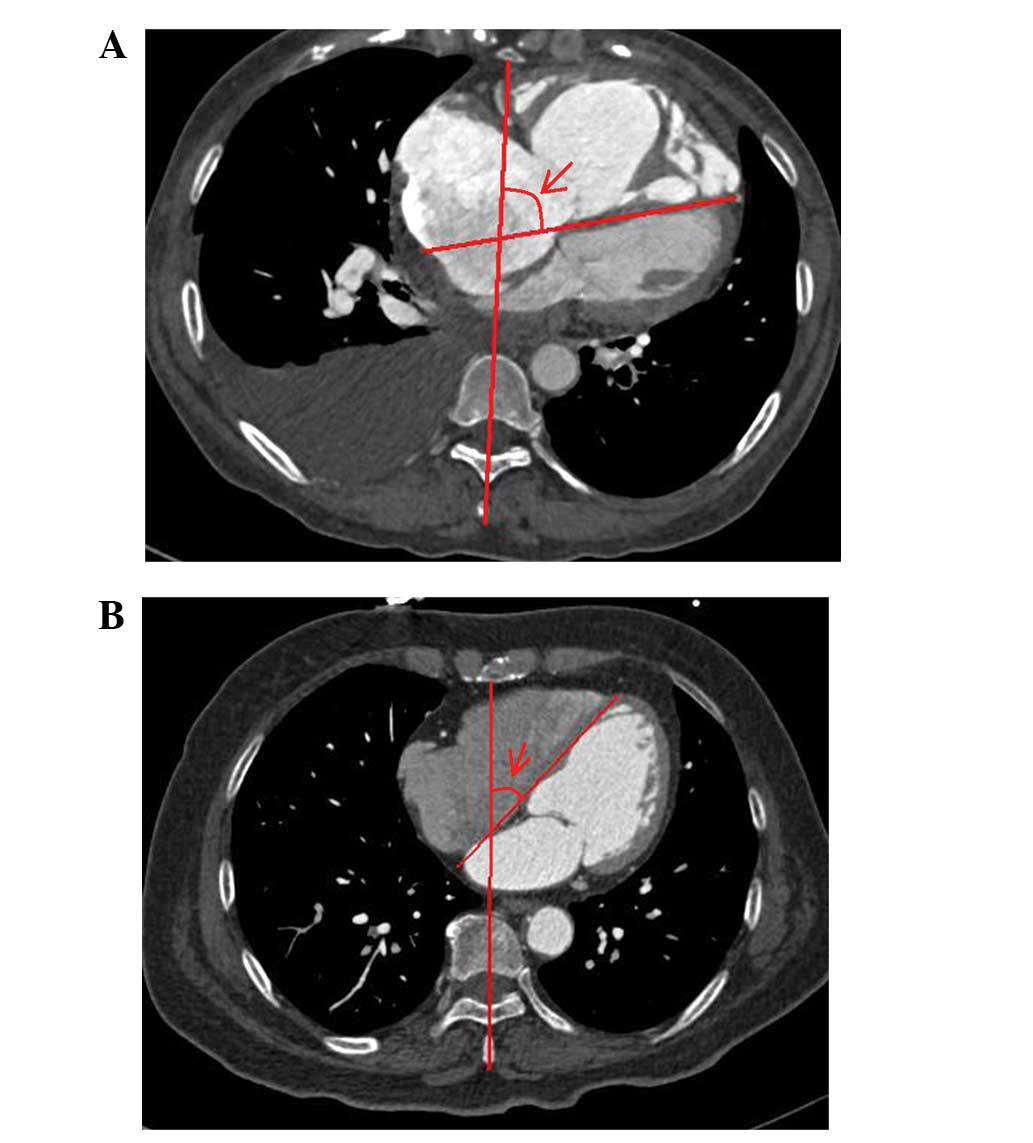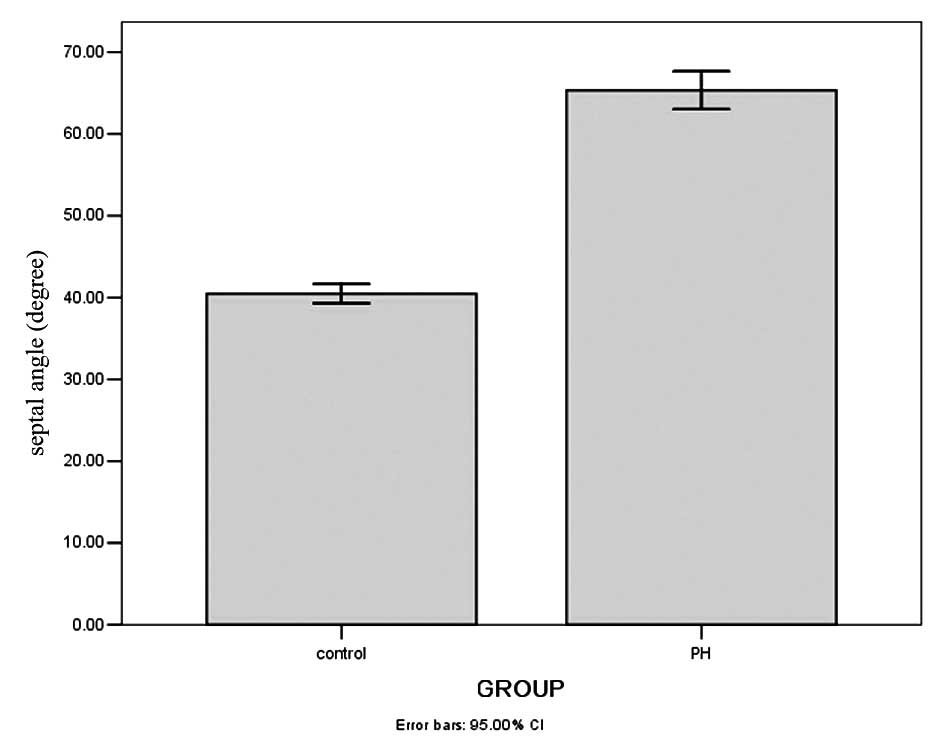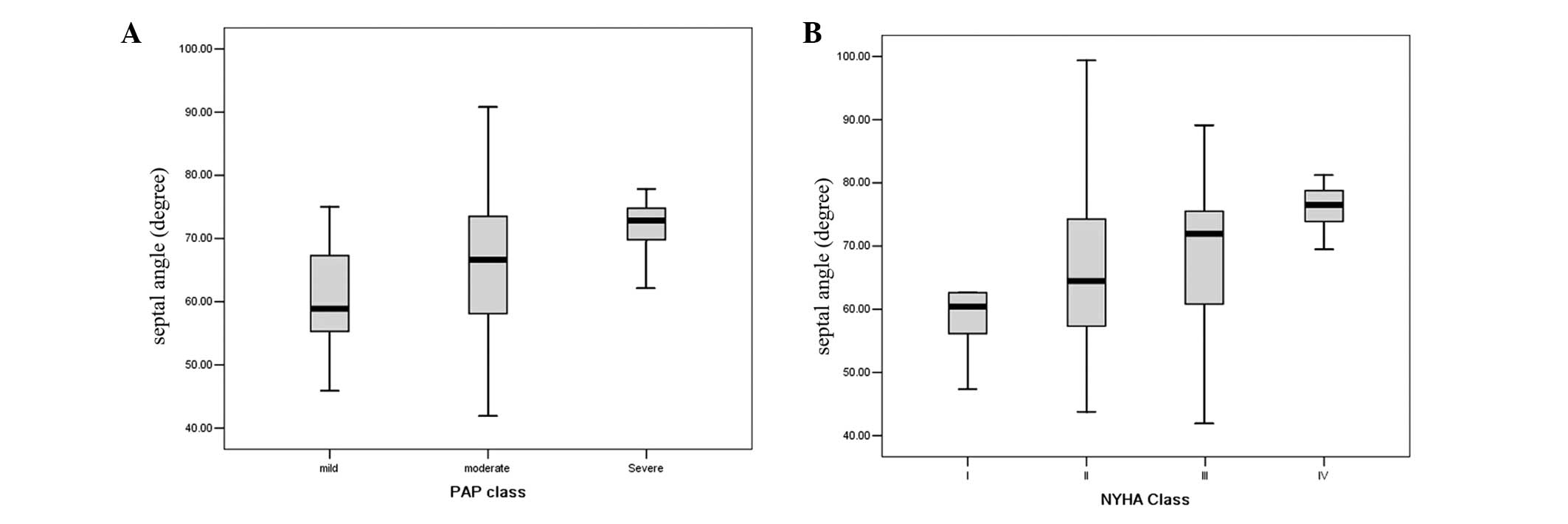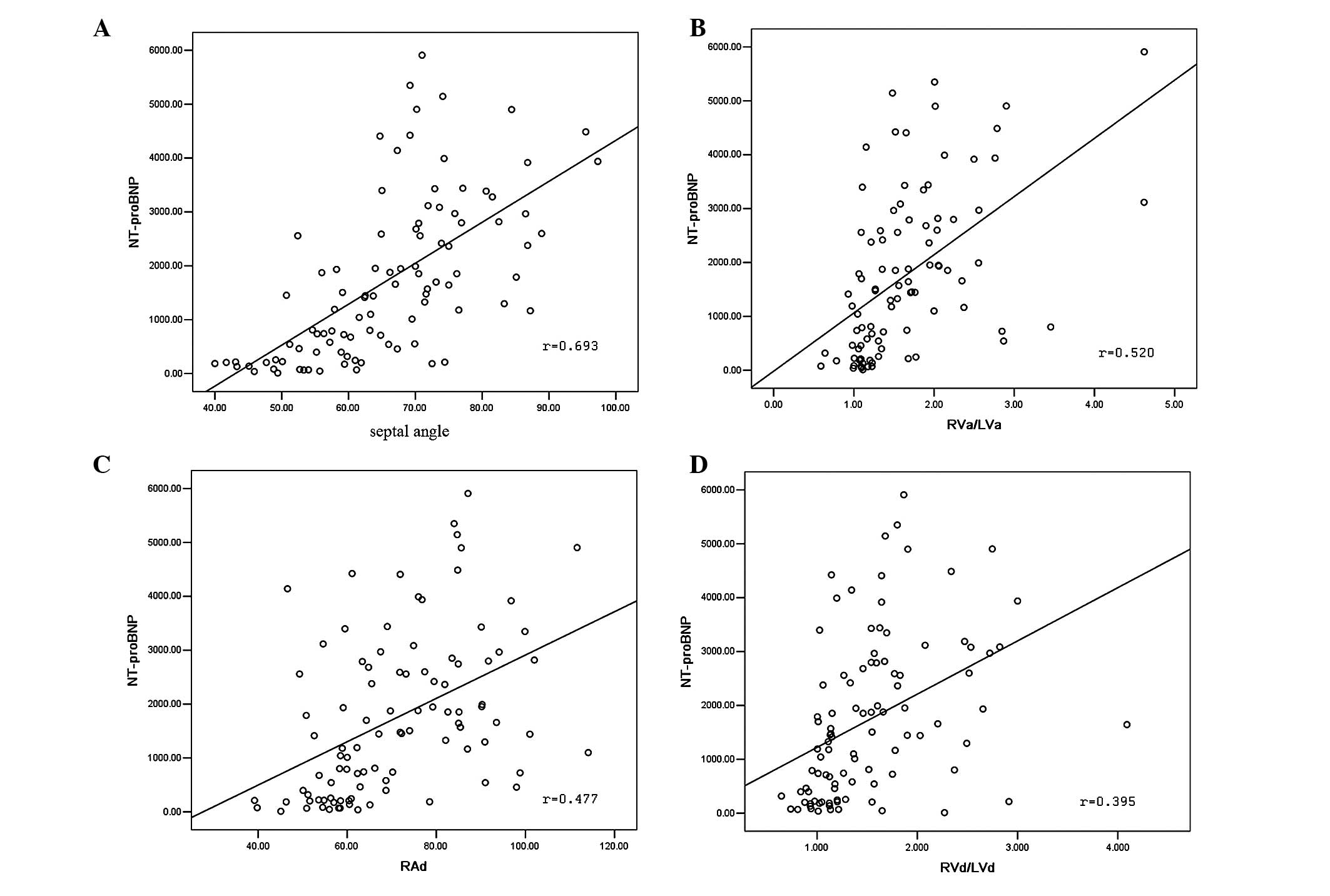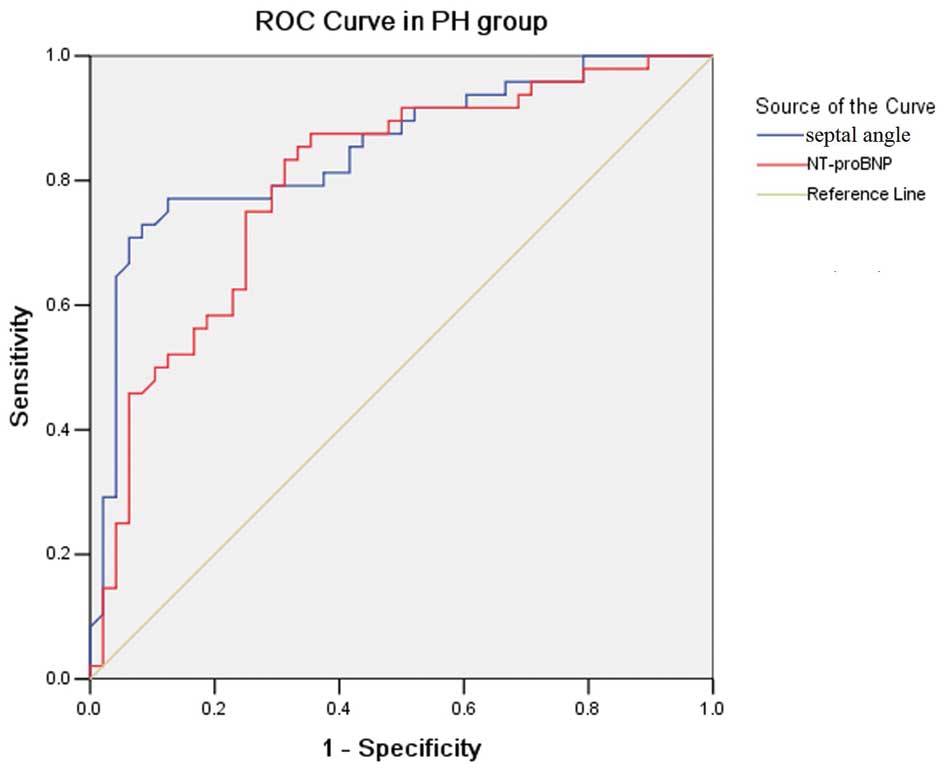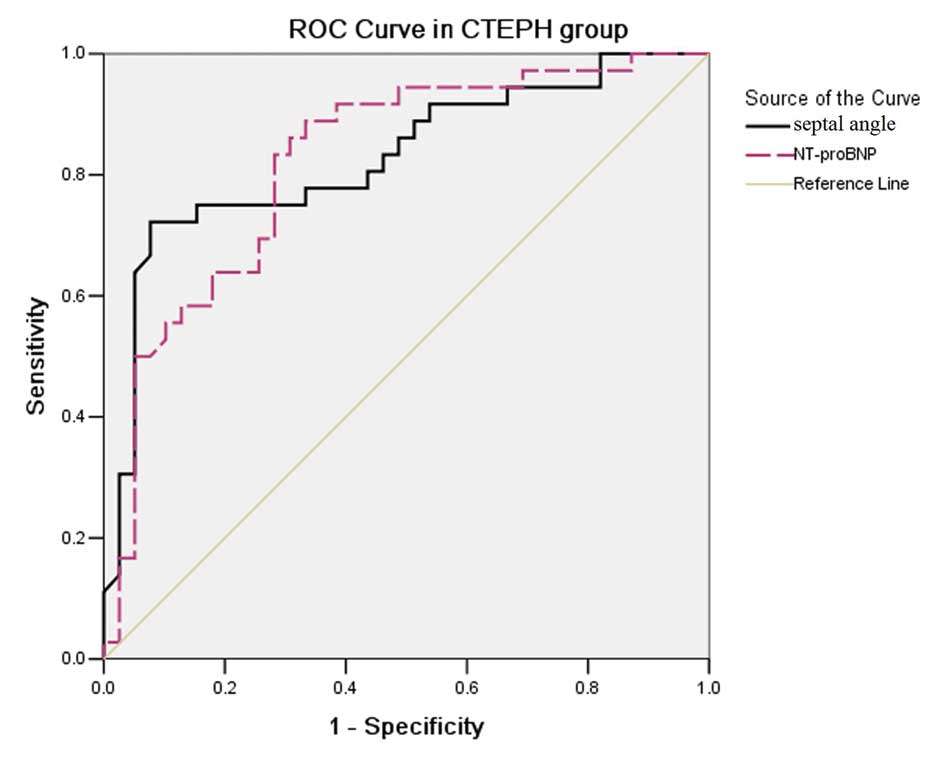Non-invasive evaluation of hemodynamics in pulmonary hypertension by a Septal angle measured by computed tomography pulmonary angiography: Comparison with right‑heart catheterization and association with N-terminal pro-B-type natriuretic peptide
- Authors:
- Published online on: September 30, 2013 https://doi.org/10.3892/etm.2013.1324
- Pages: 1350-1358
Abstract
Introduction
Pulmonary hypertension (PH) is defined as a mean pulmonary arterial pressure (mPAP) >25 mmHg at rest or as pulmonary vascular resistance (PVR) >3 Wood units (1). PH comprises apparently heterogeneous conditions that may have comparable clinical and hemodynamic characteristics, and is characterized by progressive obliteration of pulmonary arterioles, leading to the increase of PVR, right-heart failure and mortality. Over the past years, numerous advances in researching and understanding the pulmonary vascular biology have been revealed. The evaluation of the severity of PH is important in the diagnostic process and therapeutic decision-making.
The clinical history, physical examination and biochemical markers of a patient may suggest PH and right ventricular dysfunction. Currently, right-heart catheterization enables the direct measurement of hemodynamics and remains the reference standard for the evaluation of PH (2,3), and it is yet to be replaced by another approach. However, invasiveness and surgical skill requirements are the major weaknesses of heart catheterization. Echocardiography is able to evaluate pulmonary pressure and right ventricular function in a noninvasive manner. However, occasionally echocardiography underestimates the mild increased pulmonary pressure and is unable to supply information concerning emboli of the distal pulmonary artery. B-type natriuretic peptide (BNP) and its prohormone N-terminal pro-B-type natriuretic peptide (NT-proBNP) are peptides released from the myocardium, and studies suggest an abnormal increase in the NT-proBNP response to ventricular wall stress and dysfunction. In patients with PH, increasing evidence suggests that NT-proBNP is a useful marker for right ventricular dysfunction and predicts the outcome of PH (4–7).
Recently, computed tomographic pulmonary angiography (CTPA) has been used to provide much more important information, including establishing the diagnosis, defining its cause, quantifying its hemodynamic parameters, and aiding therapeutic planning and monitoring in pulmonary vascular disease. CTPA is already established as a first line test in acute pulmonary embolism (APE) (8–11). The retrospective electrocardiography (ECG)-gating technique in CT angiography now enables more comprehensive evaluation of cardiac vessels and function. Previously, studies have reported that certain cardiovascular parameters from CTPA are able to assess the extent of pulmonary artery obstruction and right ventricular function (12–15). An angle in transversal images of CTPA between the connecting line from the midpoint of the sternum to the thoracic vertebral spinous process and interventricular septum, named as Septal angle by us firstly, was reported to be correlated with PVR in patients with chronic thromboembolic pulmonary hypertension (CTEPH) (16,17). For further clarification of the role of the Septal angle in assessment severity of PH and its correlation with right ventricular function, we performed a retrospective study to explore the association between the CTPA-derived Septal angle and hemodynamics, and the level of NT-proBNP in patients with PH.
Materials and methods
Patients
Between January 2007 and March 2011, 106 consecutive patients with confirmed PH including 76 CTEPH patients and 30 pulmonary artery hypertension (PAH) patients in Peking University Shougang Hospital and Chaoyang Hospital of Capital Medical University (Beijing, China) were included in this retrospective study. PH was diagnosed according to the European Society of Cardiology (ESC)/European Respiratory Society (ERS) Guidelines (2). The medical record of each patient was reviewed by one doctor. Patients who underwent CTPA, right-heart catheterization and NT-proBNP tests were included. Exclusion criteria included the following: i) patients that were not subject to CTPA or CTPA with inferior image quality; ii) patients without right-heart catheterization; and iii) patients without NT-proBNP testing. The control group was composed of 106 age- and gender-matched control subjects without PH and pulmonary embolism. The study protocol was approved by the institutional ethics review committees of Peking University and Captial Medical University. All patients provided written informed consent.
CTPA acquisition and image analysis
A 64-row multidetector CT scanner (LightSpeed VCT; GE Healthcare, Milwaukee, WI, USA) using the retrospective ECG-gated mode was used for CTPA scanning. The whole chest was scanned from the lung apex to the diaphragm with a single breath-hold. Scan parameters included the following: current of 300–550 mA modulated by personal body mass index (BMI) dose; tube voltage of 100–140 kV and collimation of 0.625 mm, gantry rotation time of 0.8 sec, table speed of 39.37 mm/sec and reconstruction increment of 1 mm. A mechanical injector was used for intravenous bolus injection of iopromide (370 mg/ml, Ultravist; Bayer Schering Pharma, Berlin, Germany) at a flow rate of 4.5–5.0 ml/sec. The automatic bolus-tracking technique had the region of interest positioned at the level of the main pulmonary artery with a pre-defined threshold of 100 HU, and a fixed delay of 5 sec was employed for data acquisition.
Images were transferred to the electronic picture archiving and communication systems (GE Centricity 3000 RA1000; GE Healthcare) and reviewed by two radiologists together blinded to clinical information. Fig. 1 shows that the Septal angle was measured in diastole in the transverse CTPA image. According our previously described methods (15–17), other parameters including the diameter of main pulmonary artery (MPAd), diameter of ascending aorta (AAd), transverse diameter of right atrium (RAd), transverse diameter of right ventricle and left ventricle (RVd and LVd), interventricular septal thickness (IVST), and right and left ventricular area (RVa and LVa) were all measured on the transverse images. The ratio of MPAa and AAd (MPAa/AAd), the ratio of RVd and LVd (RVd/LVd) and the ratio of RVa and LVa (RVa/LVa) were measured.
Right-heart catheterization
Right-heart catheterization was used at 3–5 days after CTPA. By using the Seldinger technique, an 8F Swan-Ganz catheter (Baxter Healthcare, Irvine, CA, USA) was introduced through a right internal jugular vein and positioned under fluoroscopic guidance in a pulmonary artery. After a 10-min rest for stabilization, hemodynamic parameters including right atrial pressure (RAP), pulmonary arterial systolic pressure (sPAP), pulmonary artery diastolic pressure (dPAP), pulmonary capillary wedge pressure (PCWP) and cardiac output (CO) were obtained at end-expiration, then the mPAP and PVR were calculated. The PVR was calculated as described by Tramarin et al(18). CO was determined by the thermodilution method (19), with the exception of two cases of congenital heart disease-associated PAH where the Fick method (20) was used to determine CO, as the mean of three consecutive measurements not varying by >10%.
Plasma level of NT-proBNP
When we performed pulmonary angiography and right-heart catheterization, a blood sample was drawn from the pulmonary artery and immediately transferred into ethylenediaminetetraacetic acid-glass tubes and centrifuged at 3,000 rpm for 15 min at 4°C. The level of NT-proBNP was determined by an enzyme-linked sandwich immunoassay (Elecsys NT-proBNP; Roche Diagnostics, Indianapolis, IN, USA).
Statistical analysis
All data are expressed as mean ± standard deviation (SD), unless otherwise specified. All analyses were performed with a statistical package (SPSS 13; SPSS, Inc., Chicago, IL, USA). A Mann-Whitney U test was used to compare the Septal angle in the PH and normal control groups. The association of Septal angle with clinical parameters was calculated by univariate analysis. The correlations of Septal angle with NT-proBNP and hemodynamics were analyzed with the Spearman's correlation. Stepwise linear regression analysis was used to evaluate the predictive power of independent CTPA variables for PVR. The receiver-operating characteristic (ROC) method was used to analyze the cut-off value of Septal angle and NT-proBNP for assessing PVR ≥1,000 (dyn.sec/cm5). All P-values were for 2-sided tests. P<0.05 was considered to indicate a statistically significant result.
Results
Characteristics of the study population
The clinical characteristics of the PH group (age, 14–84 years; median, 51 years) are shown in Table I. The average Septal angle in the PH group was 65.33±11.93° with a range of 40.00–97.30° (Fig. 1A) and all patients had clear signs of PAH as revealed in Table I. In the control group, the average Septal angle was 40.47±6.11° with range of 25.50–54.50° and a median of 40.25° (Fig. 1B). As shown in Fig. 2, the Septal angle in the PH group was significantly higher than that in the control group (Mann-Whitney U test, U=280.5, P=0.000).
No correlation was observed between the Septal angle and age (r=0.101, P=0.307), BMI (r=−0.120, P=0.221) or body surface area (r=−0.150, P=0.127). The Septal angle in males and females was 65.86±13.38 and 64.78±10.36°, respectively, which has no significant difference (Mann-Whitney U test; U=1370.0, P=0.959). The Septal angle in CTEPH and PAH groups was 65.76±12.25 and 64.19±11.19°, respectively, and there was no difference in Septal angle between the two groups (Mann-Whitney U test; U=1053.5, P=0.728). The Septal angle was weakly correlated with the class of PAP (r=0.278, P=0.004; Fig. 3A) and New York Heart Association (NYHA) classification (r=0.255, P=0.009; Fig. 3B). No difference in hemodynamic parameters was identified between CTEPH and PAH, as shown in Table II.
Correlation of the Septal angle with hemodynamics and NT-proBNP in PH
Correlations between the Septal angle and the hemodynamic parameters evaluated by right-heart catheterization (Table III) showed that the Septal angle strongly correlated with PVR (r=0.642, P=0.000), moderately correlated with CO (r=−0.535, P=0.000) and cardiac index (CI; r=−0.534, P=0.000) and weakly correlated with RAP (r=0.255, P=0.009), sPAP (r=0.258, P=0.008), dPAP (r=0.275, P=0.005) and mPAP (r=0.294, P=0.002), but did not correlate with pulse oxygen saturation (SPO2; r=0.015, P=0.885) or PCWP (r=−0.025, P=0.803). Correlations between the CTPA variables and PVR (Table IV) suggest that PVR strongly correlated with the Septal angle and moderately correlated with RVa/LVa (r=0.537, P=0.000) and RVd/LVd (r=0.479, P=0.000).
When all CTPA variables were analyzed in a stepwise forward regression analysis, the Septal angle and RVa/LVa were entered into the final equation for predicting PVR, as shown in Table V, leading to the following two equations: i) PVR = 28.256 × Septal angle - 728.72; and ii) PVR = 23.005 × Septal angle + 207.992 × RVa/LVa - 718.69. The level of NT-proBNP was 1,716.09±1,498.30 pg/ml with a range of 19.79–5,909.00 pg/ml. Correlations between CTPA variables and NT-proBNP (Fig. 4) demonstrated that NT-proBNP strongly correlated with the Septal angle (r=0.693, P=0.000) and moderately correlated with RVa/LVa (r=0.520, P=0.000), RAd (r=0.447, P=0.000) and RVd/LVd (r=0.395, P=0.000).
Association of Septal angle and hemodynamics, NT-proBNP in CTEPH
In the CTEPH group, Spearman's correlations between the Septal angle and hemodynamic data evaluated by right-heart catheterization (Table III) showed that the Septal angle had a strong correlation with PVR (r=0.676, P=0.000), a moderate correlation with CO (r=−0.586, P=0.000) and CI (r=−0.595, P=0.000), a weak correlation with RAP (r=0.301, P=0.008), dPAP (r=0.251, P=0.029) and mPAP (r=0.256, P=0.026), but had no correlation with SPO2 (r=0.022, P=0.853), sPAP (r=0.209, r=0.070) or PCWP (r=−0.053, P=0.655). The level of plasma NT-proBNP in CTEPH was 1,809.52±1,532.16 pg/ml with a range of 19.79–5,909.00 pg/ml, and the Septal angle had a strong correlation with NT-proBNP (r=0.668, P=0.000).
Correlation of Septal angle and hemodynamics, NT-proBNP in PAH
In the PAH group, Spearman's correlations between Septal angle and hemodynamic data evaluated by right-heart catheterization (Table III) showed that the Septal angle strongly correlated with PVR (r=0.623, P=0.000), moderately correlated with CO (r=−0.553, P=0.000) and CI (r=−0.561, P=0.000), weakly correlated with sPAP (r=0.304, P=0.030), dPAP (r=0.387, P=0.038) and mPAP (r=0.343, P=0.016), but did not correlate with SPO2 (r=0.119, P=0.540), RAP (r=0.105, P=0.587) or PCWP (r=−0.221, P=0.249). The level of plasma NT-proBNP in PAH was 1,582.43±1,387.30 pg/ml with a range of 83.10–4,453.00 pg/ml and the Septal angle had a strong correlation with the level of NT-proBNP (r=0.616, P=0.003).
ROC analysis
In PH, as shown in ROC analysis (Fig. 5), a Septal angle cut-off point of ≥67.55° had a 77.1% sensitivity and a 87.5% specificity for predicting PVR ≥1,000 (dynes.sec.mm−5); its area under the curve (AUC) was 0.850±0.040. An NT-proBNP cut-off point ≥1,443 pg/ml had a 75.0% sensitivity and a 75.0% specificity for predicting PVR ≥1,000 (dynes.sec.mm−5); its AUC was 0.808±0.046, comparable or even inferior to the AUC of the Septal angle for predicting PVR ≥1,000 (dynes.sec.mm−5).
In the CTEPH group, ROC analysis (Fig. 6) demonstrated that a Septal angle cut-off point of ≥67.55° had a 75.0% sensitivity and a 84.6% specificity for predicting PVR ≥1,000 (dynes.sec.mm−5), and its AUC was 0.827±0.050. An NT-proBNP cut-off point of ≥1,443 pg/ml had a 83.3% sensitivity and a 71.8% specificity for predicting PVR ≥1,000 (dynes.sec.mm−5), and its AUC was 0.822±0.049, comparable to the AUC of the Septal angle for predicting PVR ≥1,000 (dynes.sec.mm−5).
Discussion
Our prior studies suggest that CTPA clearly describes the obstructed pulmonary artery (15) and the cardiovascular parameters of CTPA may be used to evaluate the hemodynamics in CTEPH (16,17). In the present study, we analyzed the correlation of Septal angle with the hemodynamics and the level of NT-proBNP in patients with PH and its two subgroups, CTEPH and PAH. We demonstrated that: i) the Septal angle in PH patients is larger than that in the normal control, but weakly correlated with PAP. ii) the Septal angle is strongly correlated with PVR and NT-proBNP in PH and its two subgroups (CTEPH and PAH). iii) In CTEPH, a Septal angle cut-off value of 67.55 has a sensitivity of 77% and a specificity of 81% in predicting PVR ≥1,000 (dyn.sec/cm5), comparable to the level of NT-proBNP. iv) In PH, a Septal angle cut-off value of 67.55° is comparable to the NT-proBNP cut-off value of 1,443 pg/ml in predicting PVR ≥1,000 (dyn.sec/cm5).
Septal angle is a CTPA-derived parameter that is an angle between the connection line from the midpoint of the sternum to thoracic vertebral spinous process and interventricular septum. This angle represents the balance of left and right ventricular load. Our results revealed that in the control group, the right ventricular (RV) pressure is lower than the left ventricular (LV) pressure; the mean Septal angle is 40.47° (range 25.50–54.50°) and the Septal angle in the PH group is significantly higher than that in the control group, but there is no difference in the CTEPH and PAH groups. This suggests the increased Septal angle is a predictor of PH, and is not affected by the etiology of PH. We observed that Septal angle only weakly increased with the extent of PAP. This suggests PAP does not directly impact on the Septal angle. Although the Septal angle in PH was not affected by age, BMI or body surface area, there was an overlap of Septal angle between PH and the control group, so the normal value of the Septal angle requires validation in a large population. During the progress of PH, the marked increase in PVR limits the rate at which the right ventricle is able to pump blood through the lungs, leading to RV overload, hypertrophy and dilatation (21–24). RV overload causes flattening and leftward displacement of the interventricular septum, and cardiac clockwise rotation, so we suggest that the enlarged septal angle is a sign of the right ventricular overload in patients with PH (23,24).
Resting hemodynamics measured by right-heart catheterization may assess the severity and predict the prognosis of PH (2,3,25). PVR is one of the most important parameters in this, since the increased PVR leads to right ventricular overload and dysfunction. Previous studies demonstrated that parameters such as RVd/LVd correlated with hemodynamic data (16,17). There is no data available so far associating the Septal angle with the resting hemodynamics of patients with PH. We observed a strong correlation of Septal angle and a moderate correlation of RVd/LVd with PVR in PH patients. By a stepwise regression analysis, the Septal angle was entered into a final equation for predicting PVR. This suggests the Septal angle may be a superior indicator for evaluating PVR than RVd/LVd. NT-proBNP is released from myocytes and may be used as an indicator of the severity of PH (26). The very high serum NT-proBNP concentrations observed in the patients with PH who were studied most likely result from an increased RV wall stretch and marked hypertrophy of the RV walls (27–29). Our data indicated that the Septal angle strongly correlated with NT-proBNP and demonstrated that the Septal angle may also be a superior predictor of severity and RV dysfunction in patients with PH.
PVR was critical in the assessment of CTEPH for its importance in the prediction of potential candidates for pulmonary endarterectomy and postoperative outcome (30) and NT-proBNP has been used as a noninvasive marker of the severity of right ventricular dysfunction in CTEPH (31). Although we did not analyze the threshold of the Septal angle in predicting the increased PVR and NT-proBNP in a large population, our results showed that the Septal angle strongly correlated with PVR and NT-proBNP in the CTEPH group. Jamieson et al(32) reported that patients with a preoperative PVR >1,000 (dynes.sec.mm−5) had a significantly higher mortality rate than those with a preoperative PVR <1,000 (dynes.sec.mm−5), so we selected 1,000 (dynes.sec.mm−5) as the threshold of PVR. We assessed the value of the Septal angle in predicting PVR ≥1,000 (dynes.sec.mm−5). Using ROC curve analysis, Septal angle >67.55° demonstrated superior sensitivity and specificity with a higher AUC to identify PVR ≥1,000 (dynes.sec.mm−5) and there was no difference in the AUC between the Septal angle and NT-proBNP level, suggesting that Septal angle and NT-proBNP have similar value in predicting a PVR ≥1,000 (dynes.sec.mm−5). These findings may be of practical importance for patients with CTEPH, CTPA not only demonstrates the distribution of clots but also supplies the information of the operability of pulmonary endarterectomy and predicts the survival of patients.
Hemodynamic data and biomarkers aid the diagnosis and assessment of PAH (33). Mukerjee et al(34) showed that NT-proBNP levels correlated significantly with PVR in scleroderma patients with PAH. Souza et al(35) showed NT-proBNP levels had a high correlation with hemodynamic parameters, particularly PVR in patients with idiopathic pulmonary artery hypertension (IPAH). Our study also showed that the Septal angle was strongly correlated with CO, PVR and NT-proBNP in PAH patients, suggesting that the severity of PAH or right heart strain as measured by hemodynamic data may be estimated using the Septal angle. However, further observation is required due to the relatively small number in this group. Fijalkowska et al(6) demonstrated that a NT-proBNP cut-off point at ≥1,400 pg/ml was useful in identifying PH patients with poor long-term prognosis. Notably, using ROC analysis, we observed a serum NT-proBNP level of ≥1,433 pg/ml has a similar value to a Septal angle of ≥67.5° for predicting the PVR ≥1,000 (dynes.sec.mm−5) in PH and CTEPH patients, suggesting the predictive value of a Septal angle ≥67.5° may also be used to evaluate the long-term prognosis in PH patients.
Although the present observations indicate that the CTPA-derived Septal angle is a useful parameter for evaluating the severity and RV dysfunction in PH, there are possible limitations. First, the retrospective design of our study allows for less generalization from our results, so although the Septal angle correlated with PVR and NT-proBNP, the correlations require further verification by prospective observations. Secondly, although the Septal angle appears to be useful in evaluating hemodynamics in patients with CTEPH, it is unclear whether operability and surgical success, defined as mortality and/or improvement of PVR, may be predicted with sufficient accuracy since only 14 patients underwent PEA. Our observations require verification from future studies of larger numbers of patients to determine the usefulness of preoperative CTPA in identifying RV dysfunction in high-risk CTEPH patients and the association with postoperative hemodynamic outcome, RV failure and mortality. Thirdly, the Septal angle appears to be useful in evaluating the severity of PH and a Septal angle ≥67.5° also may be used to evaluate the long-term prognosis. However, the lack of prognostic data in a follow-up period may be considered a major limitation of this study. The cut-off value of septal angle is able to indicate the right ventricular function and may assess the prognosis of patients with pulmonary hypertension. However, this would require a larger and homogeneous cohort, considering the numerous therapeutic options available at present.
In summary, our results suggest that the measurement of the Septal angle by CPTA is simple, noninvasive and may be a useful parameter to assess the severity and RV dysfunction in PH and its two subgroups.
Acknowledgements
The authors thank Dr Renyou Zhai for helpful comments regarding hemodynamics and Dr Xiaoxia Peng for advice on data management and for valuable suggestions about statistical analysis. This study is supported by the Beijing Clinical Medical Research Foundation (Z121107001012126).
References
|
McLaughlin VV, Archer SL, Badesch DB, et al: ACCF/AHA 2009 expert consensus document on pulmonary hypertension: a report of the American College of Cardiology Foundation Task Force on Expert Consensus Documents and the American Heart Association developed in collaboration with the American College of Chest Physicians; American Thoracic Society, Inc.; and the Pulmonary Hypertension Association. J Am Coll Cardiol. 53:1573–1619. 2009. | |
|
Galiè N, Hoeper MM, Humbert M, et al; ESC Committee for Practice Guidelines (CPG). Guidelines for the diagnosis and treatment of pulmonary hypertension: the Task Force for the Diagnosis and Treatment of Pulmonary Hypertension of the European Society of Cardiology (ESC) and the European Respiratory Society (ERS), endorsed by the International Society of Heart and Lung Transplantation (ISHLT). Eur Heart J. 30:2493–2537. 2009. | |
|
Guillinta P, Peterson KL and Ben-Yehuda O: Cardiac catheterization techniques in pulmonary hypertension. Cardiol Clin. 22:401–415. 2004. View Article : Google Scholar : PubMed/NCBI | |
|
Seino Y, Ogawa A, Yamashita T, et al: Application of NT-proBNP and BNP measurements in cardiac care: a more discerning marker for the detection and evaluation of heart failure. Eur J Heart Fail. 6:295–300. 2004. View Article : Google Scholar : PubMed/NCBI | |
|
Pruszczyk P: N-terminal pro-brain natriuretic peptide as an indicator of right ventricular dysfunction. J Card Fail. 11(5 Suppl): S65–S69. 2005. View Article : Google Scholar : PubMed/NCBI | |
|
Fijalkowska A, Kurzyna M, Torbicki A, et al: Serum N-terminal brain natriuretic peptide as a prognostic parameter in patients with pulmonary hypertension. Chest. 129:1313–1321. 2006. View Article : Google Scholar : PubMed/NCBI | |
|
Casserly B and Klinger JR: Brain natriuretic peptide in pulmonary arterial hypertension: biomarker and potential therapeutic agent. Drug Des Devel Ther. 29:269–287. 2009.PubMed/NCBI | |
|
Hoey ET, Gopalan D, Agrawal SK and Screaton NJ: Cardiac causes of pulmonary arterial hypertension: assessment with multidetector CT. Eur Radiol. 19:2557–2568. 2009. View Article : Google Scholar : PubMed/NCBI | |
|
Ghuysen A, Ghaye B, Willems V, et al: Computed tomographic pulmonary angiography and prognostic significance in patients with acute pulmonary embolism. Thorax. 60:956–961. 2005. View Article : Google Scholar : PubMed/NCBI | |
|
Collomb D, Paramelle PJ, Calaque O, et al: Severity assessment of acute pulmonary embolism: evaluation using helical CT. Eur Radiol. 13:1508–1514. 2003. View Article : Google Scholar : PubMed/NCBI | |
|
Nural MS, Elmali M, Findik S, et al: Computed tomographic pulmonary angiography in the assessment of severity of acute pulmonary embolism and right ventricular dysfunction. Acta Radiol. 50:629–637. 2009. View Article : Google Scholar | |
|
Johnson TR, Nikolaou K, Becker A, Leber AW, Rist C, Wintersperger BJ, Reiser MF and Becker CR: Dual-source CT for chest pain assessment. Eur Radiol. 18:773–780. 2008.PubMed/NCBI | |
|
Revel MP, Faivre JB, Remy-Jardin M, Delannoy-Deken V, Duhamel A and Remy J: Pulmonary hypertension: ECG-gated 64-section CT angiographic evaluation of new functional parameters as diagnostic criteria. Radiology. 250:558–566. 2009. View Article : Google Scholar : PubMed/NCBI | |
|
Doğan H, Kroft LJ, Huisman MV, van der Geest RJ and de Roos A: Right ventricular function in patients with acute pulmonary embolism: analysis with electrocardiography-synchronized multi-detector row CT. Radiology. 242:78–84. 2007.PubMed/NCBI | |
|
Liu M, Ma Z, Guo X, Zhang H, Yang Y and Wang C: Computed tomographic pulmonary angiography in the assessment of severity of chronic thromboembolic pulmonary hypertension and right ventricular dysfunction. Eur J Radiol. 80:e462–e469. 2011. View Article : Google Scholar | |
|
Liu M, Ma ZH, Guo XJ, et al: A septal angle measured on computed tomographic pulmonary angiography can noninvasively estimate pulmonary vascular resistance in patients with chronic thromboembolic pulmonary hypertension. J Thorac Imaging. 27:325–330. 2012. View Article : Google Scholar | |
|
Liu M, Ma Z, Guo X, Chen X, Yang Y and Wang C: Cardiovascular parameters of computed tomographic pulmonary angiography to assess pulmonary vascular resistance in patients with chronic thromboembolic pulmonary hypertension. Int J Cardiol. 164:295–300. 2013. View Article : Google Scholar | |
|
Tramarin R, Torbicki A, Marchandise B, Laaban JP and Morpurgo M; Working Group on Noninvasive Evaluation of Pulmonary Artery Pressure. European Office of the World Health Organization, Copenhagen. Doppler echocardiographic evaluation of pulmonary artery pressure in chronic obstructive pulmonary disease. A European multicentre study. Eur Heart J. 12:103–111. 1991. | |
|
Ganz W, Donoso R, Marcus HS, Forrester JS and Swan HJ: A new technique for measurement of cardiac output by thermodilution in man. Am J Cardiol. 27:392–396. 1971. View Article : Google Scholar : PubMed/NCBI | |
|
McMichael J and Sharpey-Schafer EP: Cardiac output in man by a direct fick method: Effects of posture, venous pressure change, atropine, and adrenaline. Br Heart J. 6:33–40. 1944. View Article : Google Scholar : PubMed/NCBI | |
|
Bogaard HJ, Abe K, Vonk Noordegraaf A and Voelkel NF: The right ventricle under pressure: cellular and molecular mechanisms of right-heart failure in pulmonary hypertension. Chest. 135:794–804. 2009. View Article : Google Scholar : PubMed/NCBI | |
|
Delcroix M, Vonk Noordegraaf A, Fadel E, Lang I, Simonneau G and Naeije R: Vascular and right ventricular remodelling in chronic thromboembolic pulmonary hypertension. Eur Respir J. 41:224–232. 2013. View Article : Google Scholar : PubMed/NCBI | |
|
Sitbon O, Humbert M, Nunes H, et al: Long-term intravenous epoprostenol infusion in primary pulmonary hypertension: prognostic factors and survival. J Am Coll Cardiol. 40:780–788. 2002. View Article : Google Scholar : PubMed/NCBI | |
|
Raymond RJ, Hinderliter AL, Willis PW, Ralph D, et al: Echocardiographic predictors of adverse outcomes in primary pulmonary hypertension. J Am Coll Cardiol. 39:1214–1219. 2002. View Article : Google Scholar : PubMed/NCBI | |
|
McGoon M, Gutterman D, Steen V, Barst R, et al: Screening, early detection, and diagnosis of pulmonary arterial hypertension: ACCP evidence based clinical practice guidelines. Chest. 126(1 Suppl): 14S–34S. 2004. View Article : Google Scholar : PubMed/NCBI | |
|
Andreassen AK, Wergeland R, Simonsen S, Geiran O, Guevara C and Ueland T: N-terminal pro-B-type natriuretic peptide as an indicator of disease severity in a heterogeneous group of patients with chronic precapillary pulmonary hypertension. Am J Cardiol. 98:525–529. 2006. View Article : Google Scholar : PubMed/NCBI | |
|
Nagaya N, Nishikimi T, Okano Y, et al: Plasma brain natriuretic peptide levels increase in proportion to the extent of right ventricular dysfunction in pulmonary hypertension. J Am Coll Cardiol. 31:202–208. 1998. View Article : Google Scholar | |
|
McDonagh TA, Holmer S, Raymond I, Luchner A, Hildebrant P and Dargie HJ: NT-proBNP and the diagnosis of heart failure: a pooled analysis of three European epidemiological studies. Eur J Heart Fail. 6:269–273. 2004. View Article : Google Scholar : PubMed/NCBI | |
|
Yap LB, Ashrafian H, Mukerjee D, Coghlan JG and Timms PM: The natriuretic peptides and their role in disorders of right heart dysfunction and pulmonary hypertension. Clin Biochem. 37:847–856. 2004. View Article : Google Scholar : PubMed/NCBI | |
|
D'Armini AM, Cattadori B, Monterosso C, et al: Pulmonary thromboendarterectomy in patients with chronic thromboembolic pulmonary hypertension: hemodynamic characteristics and changes. Eur J Cardiothorac Surg. 18:696–702. 2000. View Article : Google Scholar | |
|
Reesink HJ, Tulevski II, Marcus JT, Boomsma F, et al: Brain natriuretic peptide as noninvasive marker of the severity of right ventricular dysfunction in chronic thromboembolic pulmonary hypertension. Ann Thorac Surg. 84:537–543. 2007. View Article : Google Scholar | |
|
Jamieson SW, Kapelanski DP, Sakakibara N, et al: Pulmonary endarterectomy: experience and lessons learned in 1,500 cases. Ann Thorac Surg. 76:1457–1464. 2003. View Article : Google Scholar : PubMed/NCBI | |
|
Badesch DB, Champion HC, Sanchez MA, et al: Diagnosis and assessment of pulmonary arterial hypertension. J Am Coll Cardiol. 54(1 Suppl): S55–S66. 2009. View Article : Google Scholar : PubMed/NCBI | |
|
Mukerjee D, Yap LB, Holmes AM, Nair D, et al: Significance of plasma N-terminal pro-brain natriuretic peptide in patients with systemic sclerosis-related pulmonary arterial hypertension. Respir Med. 97:1230–1236. 2003. View Article : Google Scholar : PubMed/NCBI | |
|
Souza R, Jardim C, Julio Cesar Fernandes C, Silveira Lapa M, et al: NT-proBNP as a tool to stratify disease severity in pulmonary arterial hypertension. Respir Med. 101:69–75. 2007. View Article : Google Scholar : PubMed/NCBI |



